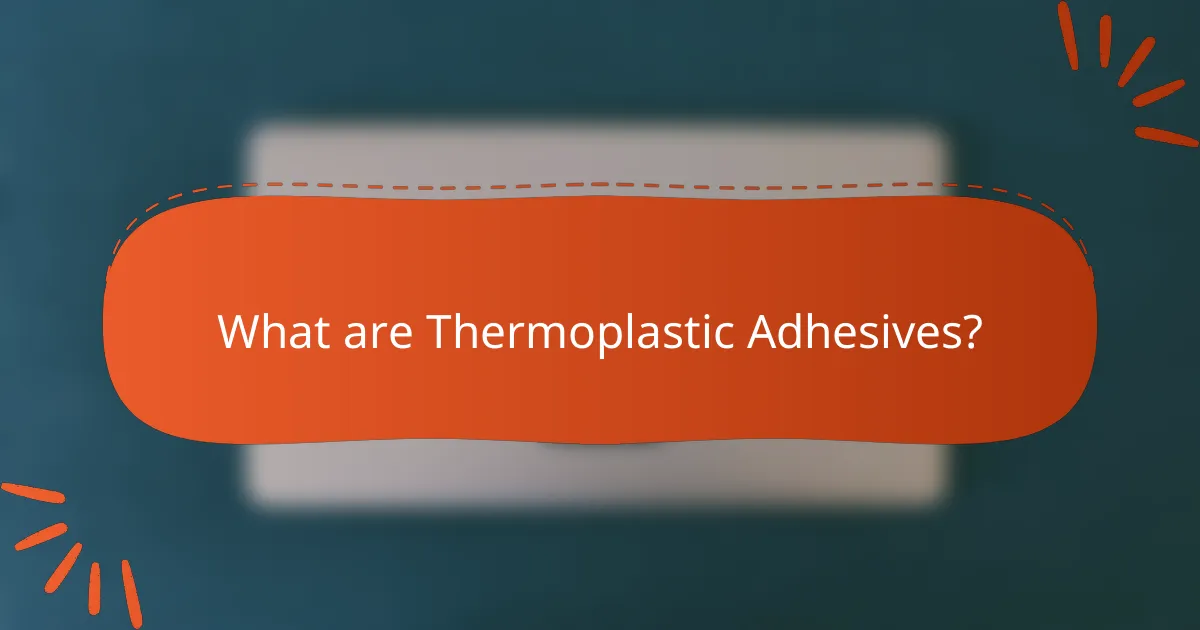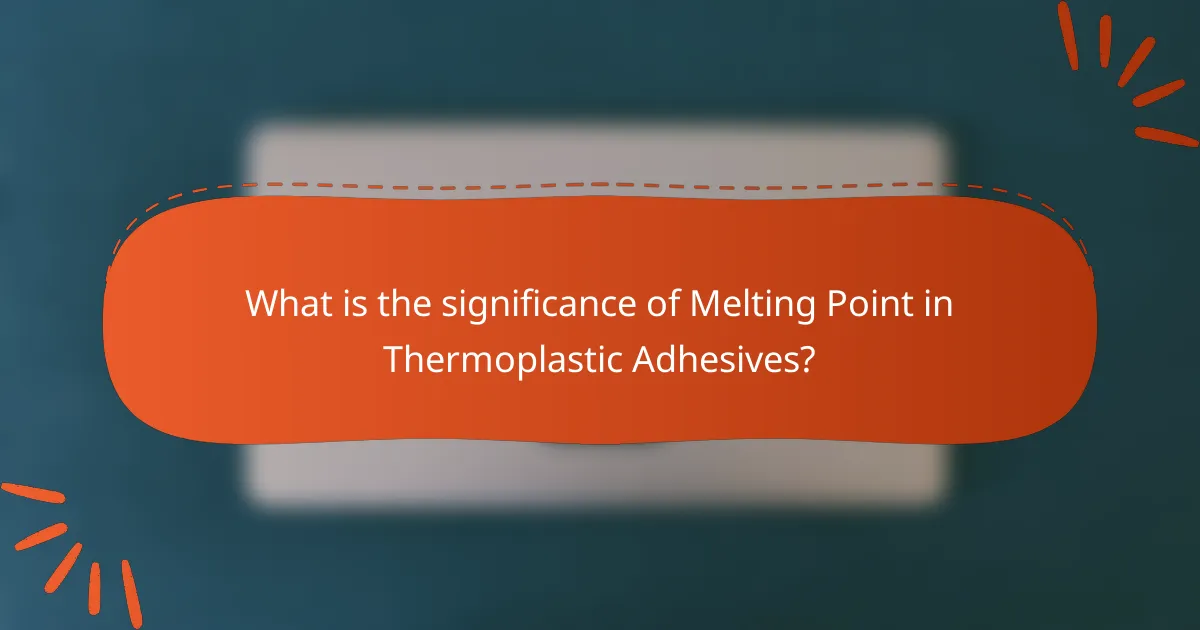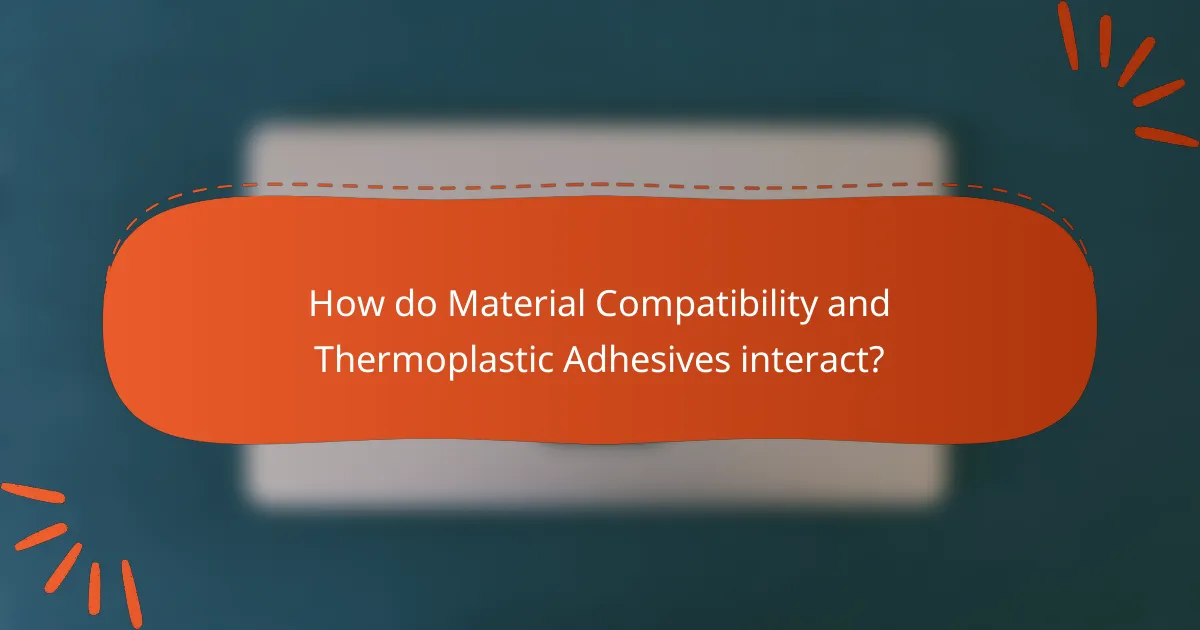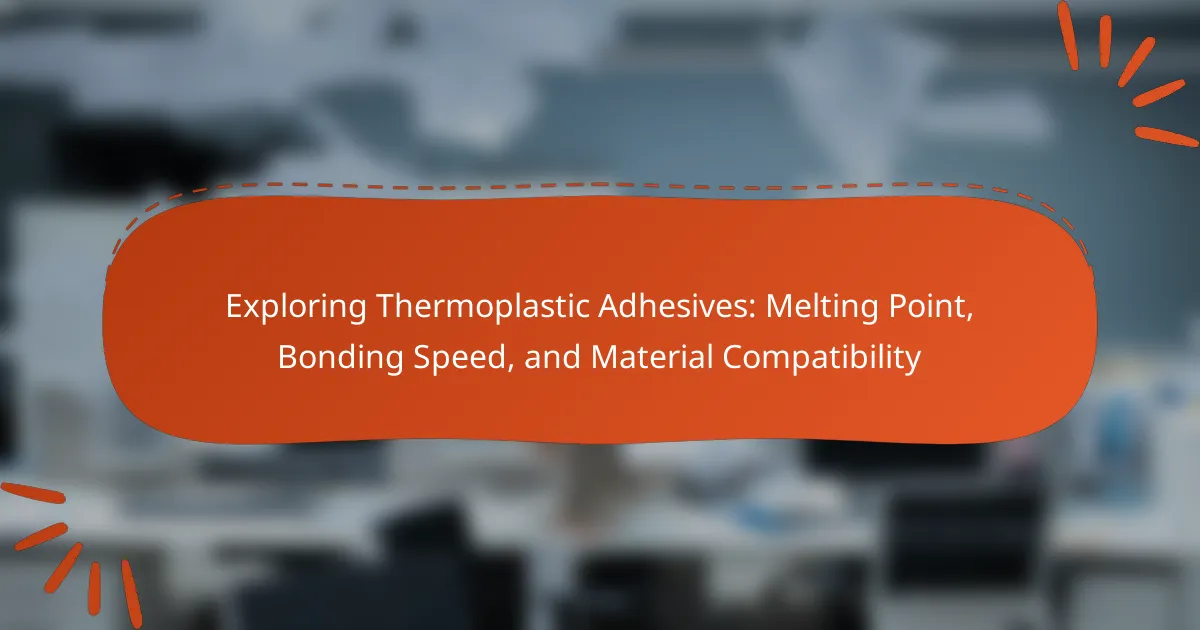Thermoplastic adhesives are versatile bonding agents that become pliable when heated and solidify upon cooling, forming strong connections between various materials. This article explores critical aspects of thermoplastic adhesives, including their melting points, which determine their application efficiency and thermal stability. It also examines bonding speeds that enhance production efficiency and the importance of material compatibility, which affects adhesion strength. Understanding these factors is essential for selecting the right adhesive for specific applications, ensuring optimal performance across industries such as packaging, automotive, and electronics.

What are Thermoplastic Adhesives?
Thermoplastic adhesives are a type of adhesive that becomes pliable or moldable upon heating. They solidify upon cooling, forming a strong bond between materials. These adhesives are commonly used in various applications, including packaging, automotive, and electronics. Thermoplastic adhesives can bond a wide range of substrates, such as plastics, metals, and wood. Their versatility makes them suitable for both industrial and consumer use. They typically offer quick bonding speeds, enhancing production efficiency. The melting point of thermoplastic adhesives varies depending on their formulation, impacting their application. Overall, thermoplastic adhesives provide a reliable solution for joining materials in numerous industries.
How do Thermoplastic Adhesives differ from other adhesives?
Thermoplastic adhesives differ from other adhesives primarily in their ability to be re-melted and reformed. This unique characteristic allows them to be applied in a molten state and solidify upon cooling. Unlike thermosetting adhesives, which cure permanently, thermoplastic adhesives can be reactivated by heat. This reusability makes thermoplastic adhesives suitable for applications requiring temporary bonds or adjustments. Additionally, they often provide rapid bonding speeds, enabling quicker assembly processes. Their compatibility with various substrates is also notable, as they can bond plastics, metals, and composites effectively. These attributes make thermoplastic adhesives versatile for industries such as automotive and packaging.
What are the key characteristics of Thermoplastic Adhesives?
Thermoplastic adhesives are characterized by their ability to melt upon heating and solidify upon cooling. This property allows for reversible bonding, making them versatile for various applications. They exhibit strong adhesion to a wide range of materials, including plastics, metals, and wood. Thermoplastic adhesives typically have a fast bonding speed, enabling quick assembly processes. Their melting points can vary significantly, often ranging from 80°C to 200°C. They are also resistant to moisture and chemicals, enhancing durability in diverse environments. These adhesives can be reprocessed multiple times without significant degradation, providing an eco-friendly option for manufacturing.
Why are Thermoplastic Adhesives preferred in certain applications?
Thermoplastic adhesives are preferred in certain applications due to their rapid bonding capabilities and versatility. These adhesives can bond a variety of materials, including plastics, metals, and wood. Their melting point allows for easy application, as they can be heated and re-melted multiple times without losing effectiveness. This reusability makes them cost-effective for manufacturing processes. Additionally, thermoplastic adhesives provide strong, flexible bonds that can withstand temperature fluctuations. Their resistance to moisture and chemicals further enhances their suitability for diverse environments. Overall, these attributes make thermoplastic adhesives ideal for industries such as automotive, packaging, and electronics.
What are the primary types of Thermoplastic Adhesives?
The primary types of thermoplastic adhesives include hot melt adhesives, pressure-sensitive adhesives, and reactive adhesives. Hot melt adhesives are solid at room temperature and become liquid upon heating. They bond quickly upon cooling, making them suitable for various applications. Pressure-sensitive adhesives adhere upon application of light pressure without the need for heat or solvent. They are commonly used in tapes and labels. Reactive adhesives cure through a chemical reaction, providing strong bonds after application. Each type has unique properties that make them suitable for specific materials and uses.
What are the common formulations of Thermoplastic Adhesives?
Common formulations of thermoplastic adhesives include ethylene-vinyl acetate (EVA), polyamide, and polyurethane. EVA is widely used due to its flexibility and strong adhesion. Polyamide adhesives are known for their heat resistance and durability. Polyurethane formulations provide excellent bonding to various substrates and are often used in automotive applications. Additionally, styrene block copolymers are utilized for their elasticity and toughness. These formulations are chosen based on specific application needs, such as temperature resistance and adhesion strength.
How do different types of Thermoplastic Adhesives vary in performance?
Different types of thermoplastic adhesives vary in performance based on their chemical composition and physical properties. For example, polyamide adhesives offer high thermal resistance and are suitable for demanding applications. In contrast, ethylene-vinyl acetate (EVA) adhesives provide excellent flexibility and adhesion to various substrates. Performance also differs in melting point, affecting the bonding speed and application temperature range. Polyurethane adhesives exhibit strong bonding capabilities on diverse materials, while styrenic block copolymers are known for their good elasticity and impact resistance. These variations are crucial for selecting the appropriate adhesive for specific applications.

What is the significance of Melting Point in Thermoplastic Adhesives?
The melting point is significant in thermoplastic adhesives as it determines the temperature at which the adhesive transitions from a solid to a liquid state. This transition is crucial for effective bonding. A lower melting point allows for faster application and curing times. Conversely, a higher melting point may offer better thermal stability in applications. The specific melting point influences the adhesive’s performance in various environmental conditions. For instance, adhesives with higher melting points can withstand elevated temperatures without losing their bond strength. Understanding the melting point helps in selecting the appropriate adhesive for specific materials and applications. This ensures optimal performance and durability in the final product.
How does Melting Point affect the application of Thermoplastic Adhesives?
The melting point of thermoplastic adhesives significantly influences their application. A higher melting point allows for better heat resistance in bonding applications. This is crucial for industries where thermal stability is required, such as automotive and aerospace. Conversely, a lower melting point facilitates easier processing and application at lower temperatures. This can be advantageous in delicate materials that cannot withstand high heat. The choice of melting point directly affects the adhesive’s performance in various environments. For instance, adhesives with melting points below 100°C are often used for packaging applications. In contrast, those above 200°C are suitable for high-performance industrial uses. Therefore, understanding the melting point is essential for selecting the appropriate thermoplastic adhesive for specific applications.
What role does Melting Point play in the bonding process?
Melting point is crucial in the bonding process of thermoplastic adhesives. It determines the temperature at which the adhesive transitions from a solid to a liquid state. This transition allows the adhesive to flow and fill gaps between surfaces. When the adhesive cools, it solidifies and forms a strong bond. The melting point affects the bonding speed; lower melting points enable quicker application and setting. Additionally, the melting point influences material compatibility. Adhesives with appropriate melting points bond effectively with various substrates. Different thermoplastic adhesives have varying melting points, which should match the materials being bonded for optimal results.
How can the Melting Point influence the choice of adhesive for specific materials?
The melting point of an adhesive significantly influences its suitability for bonding specific materials. Adhesives with a melting point lower than the materials being bonded may fail under heat. Conversely, adhesives with a higher melting point can withstand elevated temperatures without losing adhesion. For example, thermoplastic adhesives, which become pliable at their melting point, can effectively bond materials that experience thermal expansion. Additionally, the melting point dictates the processing temperature during application. Selecting an adhesive with an appropriate melting point ensures optimal bonding performance and longevity. Thus, understanding the melting point is crucial for effective adhesive selection.
Why is Bonding Speed important in Thermoplastic Adhesives?
Bonding speed is crucial in thermoplastic adhesives because it determines the efficiency of the adhesive application process. Faster bonding speeds lead to quicker assembly times in manufacturing. This efficiency can significantly reduce production costs and enhance productivity. Additionally, rapid bonding allows for immediate handling of bonded materials. This is particularly important in industries where time-to-market is critical. Studies show that adhesives with optimal bonding speeds can improve overall product performance. For instance, a faster bond formation can enhance the durability of the adhesive joint. Therefore, bonding speed directly impacts both operational efficiency and product quality in thermoplastic adhesive applications.
What factors influence the Bonding Speed of Thermoplastic Adhesives?
The bonding speed of thermoplastic adhesives is influenced by several key factors. These factors include the adhesive’s temperature, which affects its viscosity and flow. Higher temperatures generally increase bonding speed by reducing viscosity. The surface preparation of the materials also plays a crucial role. Clean and roughened surfaces enhance adhesion and speed up bonding. Additionally, the type of thermoplastic adhesive used can impact the bonding speed. Different formulations have varying curing times and properties. The ambient temperature and humidity conditions during application further affect the bonding speed. Lastly, the pressure applied during bonding influences the speed, as adequate pressure ensures better contact between surfaces.
How does Bonding Speed impact production efficiency?
Bonding speed directly affects production efficiency by determining the rate at which materials can be joined. Faster bonding speeds reduce cycle times in manufacturing processes. This leads to increased output and productivity. For instance, in automated assembly lines, a bonding speed of 5 seconds per joint can significantly enhance throughput compared to a speed of 20 seconds. Studies show that optimizing bonding speed can improve overall efficiency by up to 30%. Efficient bonding processes minimize downtime and reduce labor costs. Therefore, higher bonding speeds contribute to streamlined operations and better resource utilization.

How do Material Compatibility and Thermoplastic Adhesives interact?
Material compatibility significantly influences the performance of thermoplastic adhesives. Thermoplastic adhesives bond effectively to materials with similar surface energies. High surface energy materials, like metals and glass, typically achieve strong adhesion. Low surface energy materials, such as polyethylene, may require surface treatments for effective bonding. Chemical compatibility is also crucial; incompatible materials can lead to bond failure. For example, certain thermoplastic adhesives do not adhere well to rubber or silicone-based substrates. Testing is essential to ensure successful adhesion in specific applications.
What factors determine Material Compatibility with Thermoplastic Adhesives?
Material compatibility with thermoplastic adhesives is determined by several key factors. These factors include surface energy, chemical composition, and thermal properties of the materials involved. Surface energy affects adhesive bonding; higher surface energy materials bond better with adhesives. Chemical composition influences how adhesives interact with substrates; polar and non-polar interactions play a significant role. Thermal properties, such as melting point and thermal expansion, impact the adhesive’s performance during application and service. The compatibility of thermoplastic adhesives is also affected by the presence of contaminants or surface treatments on the materials. Understanding these factors ensures effective bonding and optimal performance of thermoplastic adhesives in various applications.
How can understanding Material Compatibility improve adhesive performance?
Understanding material compatibility significantly enhances adhesive performance. It ensures that the adhesive bonds effectively with the materials involved. Compatible materials allow for optimal adhesion, reducing the risk of bond failure. This compatibility can be assessed through factors like surface energy and chemical composition. For instance, high surface energy materials typically bond better with adhesives. Conversely, mismatched materials can lead to weak bonds and reduced durability. Research indicates that proper material pairing can increase bond strength by up to 50%. Therefore, understanding material compatibility is crucial for successful adhesive applications.
What are the common materials used with Thermoplastic Adhesives?
Common materials used with thermoplastic adhesives include plastics, metals, wood, and ceramics. These adhesives bond well to polyolefins, polyamides, and PVC. They also adhere effectively to aluminum and steel surfaces. Wood and ceramic materials benefit from thermoplastic adhesives due to their flexibility and strength. The compatibility of these materials enhances the adhesive’s performance in various applications. Research shows that thermoplastic adhesives can provide strong bonds across these materials, making them versatile in manufacturing and assembly processes.
What are best practices for using Thermoplastic Adhesives effectively?
Best practices for using thermoplastic adhesives effectively include ensuring proper surface preparation. Surfaces should be clean, dry, and free from contaminants. This enhances adhesion and bond strength. Next, select the appropriate adhesive type based on material compatibility. Different thermoplastic adhesives work better with specific substrates.
Heating the adhesive to the recommended melting point is crucial. This ensures optimal flow and bonding. Apply the adhesive evenly to achieve a uniform bond. Monitor the application time to ensure that the adhesive is used within its working time.
Clamp or hold the materials together during the curing process. This prevents movement and ensures a strong bond. Finally, allow sufficient curing time before subjecting the bond to stress. Following these practices will maximize the effectiveness of thermoplastic adhesives.
How can users troubleshoot common issues with Thermoplastic Adhesives?
Users can troubleshoot common issues with thermoplastic adhesives by following specific steps. First, ensure proper temperature settings during application. Thermoplastic adhesives require precise melting points for effective bonding. Next, check the surface preparation of the materials being bonded. Clean and dry surfaces enhance adhesion. Additionally, verify the adhesive’s compatibility with the materials. Incompatible materials can lead to weak bonds. Users should also monitor the curing time. Insufficient curing can cause the adhesive to fail. Lastly, inspect for environmental factors such as humidity and temperature fluctuations. These can impact adhesive performance. By addressing these areas, users can effectively resolve issues with thermoplastic adhesives.
What tips can enhance the performance of Thermoplastic Adhesives in various applications?
To enhance the performance of thermoplastic adhesives, ensure proper surface preparation. Clean surfaces remove contaminants that can weaken adhesion. Use appropriate temperature settings during application. The melting point of the adhesive should match the substrate’s requirements. Optimize bonding time for effective curing. Insufficient time can lead to weak bonds. Consider the compatibility of materials being bonded. Different substrates may require specific adhesive formulations. Apply uniform pressure during bonding to improve contact area. This maximizes adhesive performance and bond strength. Lastly, store adhesives properly to maintain their properties. Improper storage can degrade adhesive quality over time.
Thermoplastic adhesives are versatile bonding agents that become pliable when heated and solidify upon cooling, making them suitable for various applications across industries such as automotive, packaging, and electronics. This article explores key characteristics of thermoplastic adhesives, including their melting points, bonding speeds, and material compatibility, which significantly influence their performance and application. It also examines different types of thermoplastic adhesives, common formulations, and best practices for effective use, providing a comprehensive understanding of how these adhesives can enhance manufacturing processes and product durability. Understanding these factors is crucial for selecting the appropriate adhesive for specific materials and applications.



